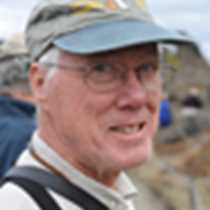Lake Eva, Baranof Island, Alaska
Exploration day – a day to explore the coastal rainforest of Baranof Island by foot and kayak. Our hiking trail took us through the ancient forest, hundreds of years in development. We passed giant Sitka spruce trees and paused to look at cone middens where red squirrels had cached the cones of spruce in fall and then survived the winter by pealing away the cone scales to feast on the small seeds within. We passed under Western hemlocks draped with moss and lichens. Fallen hemlock from earlier times now serve as nurse logs, with seedlings of Alaska blueberry, huckleberry, and the next generation of hemlock germinating and beginning their growth in the moss that coats the fallen log. Our trail took us along a stream that later will team with spawning salmon. Today it provided an opening on the forest in which we could see bright red-breasted sapsuckers. The high, thin whistle of varied thrushes came down from the forest canopy, and the complex melodic song of the tiny winter wren from the streamside shrubs. We passed through bogs of Western skunk cabbage, their flowering head or spathe still surrounded by a yellow “pulpit”. The odor given off by the skunk cabbage ... few would call it pleasant ... attests to the kinds of insects that it attracts as pollinators. Skunk cabbage is important early season food for brown bears soon after they have merged from their long winter nap, and we could see that bears had been here feeding. In fact, the “ABC Islands” of Southeastern Alaska – Admiralty, Baranof, and Chichagof - support the highest density of brown bears of any place in America.
Some had returned to the beach to begin their exploration by kayak; others were nearing the beach to do the same. Our return was interrupted, for on the very trail that had been our outbound hiking route, we encountered this female brown bear and single year-old cub. They were foraging on grasses just above the high-tide line, aware but showing any sign of concern over our presence. Some commented on the bears using our trail, but in fact we were using their trail, and we were more than happy to alter our plans to accommodate their meal schedule!
Exploration day – a day to explore the coastal rainforest of Baranof Island by foot and kayak. Our hiking trail took us through the ancient forest, hundreds of years in development. We passed giant Sitka spruce trees and paused to look at cone middens where red squirrels had cached the cones of spruce in fall and then survived the winter by pealing away the cone scales to feast on the small seeds within. We passed under Western hemlocks draped with moss and lichens. Fallen hemlock from earlier times now serve as nurse logs, with seedlings of Alaska blueberry, huckleberry, and the next generation of hemlock germinating and beginning their growth in the moss that coats the fallen log. Our trail took us along a stream that later will team with spawning salmon. Today it provided an opening on the forest in which we could see bright red-breasted sapsuckers. The high, thin whistle of varied thrushes came down from the forest canopy, and the complex melodic song of the tiny winter wren from the streamside shrubs. We passed through bogs of Western skunk cabbage, their flowering head or spathe still surrounded by a yellow “pulpit”. The odor given off by the skunk cabbage ... few would call it pleasant ... attests to the kinds of insects that it attracts as pollinators. Skunk cabbage is important early season food for brown bears soon after they have merged from their long winter nap, and we could see that bears had been here feeding. In fact, the “ABC Islands” of Southeastern Alaska – Admiralty, Baranof, and Chichagof - support the highest density of brown bears of any place in America.
Some had returned to the beach to begin their exploration by kayak; others were nearing the beach to do the same. Our return was interrupted, for on the very trail that had been our outbound hiking route, we encountered this female brown bear and single year-old cub. They were foraging on grasses just above the high-tide line, aware but showing any sign of concern over our presence. Some commented on the bears using our trail, but in fact we were using their trail, and we were more than happy to alter our plans to accommodate their meal schedule!




